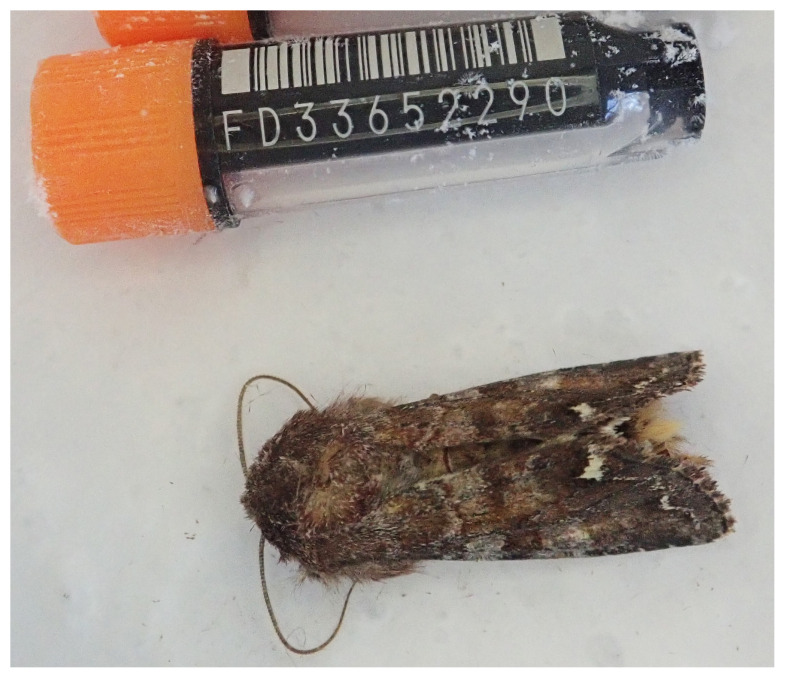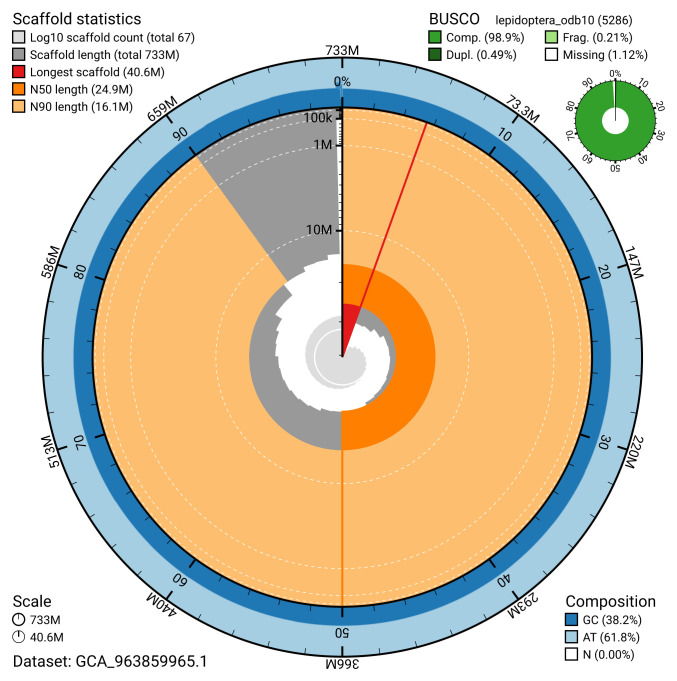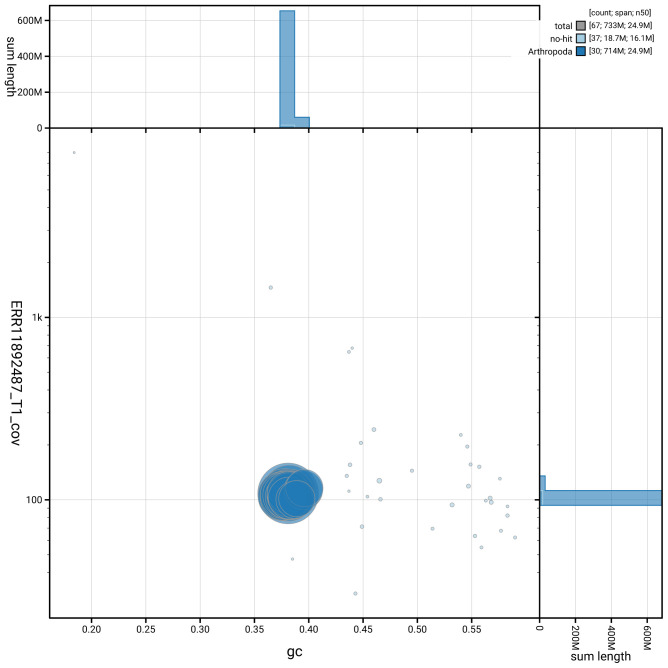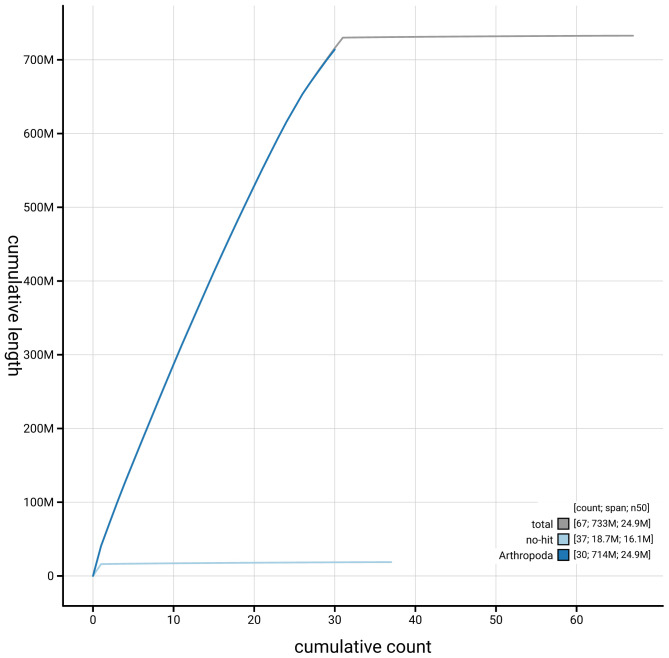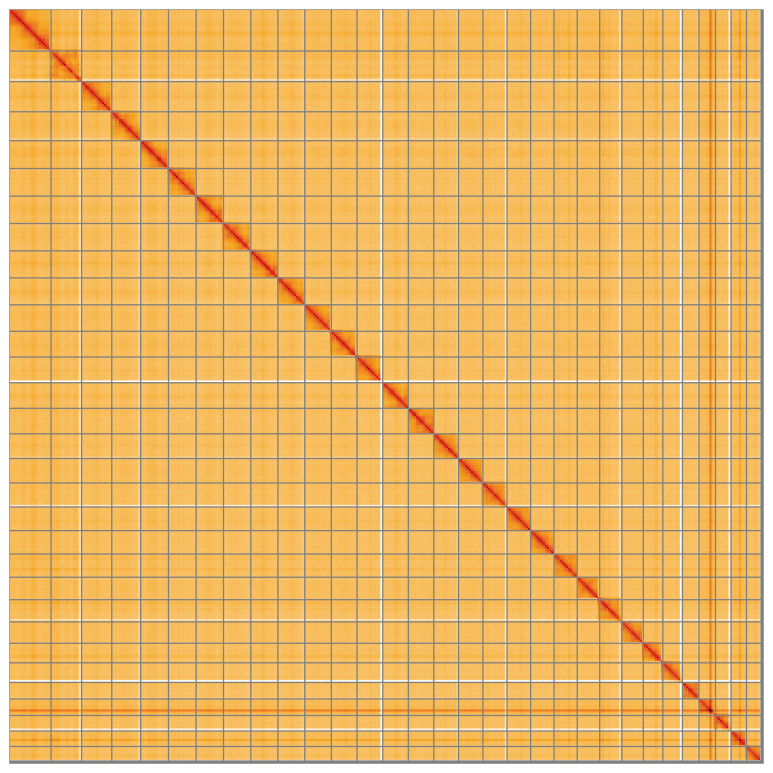Abstract
We present a genome assembly from an individual male Ceramica pisi (the Broom moth; Arthropoda; Insecta; Lepidoptera; Noctuidae). The genome sequence spans 732.70 megabases. Most of the assembly is scaffolded into 31 chromosomal pseudomolecules, including the Z sex chromosome. The mitochondrial genome has also been assembled and is 15.31 kilobases in length. Gene annotation of this assembly on Ensembl identified 12,916 protein-coding genes.
Keywords: Ceramica pisi, Broom moth, genome sequence, chromosomal, Lepidoptera
Species taxonomy
Eukaryota; Opisthokonta; Metazoa; Eumetazoa; Bilateria; Protostomia; Ecdysozoa; Panarthropoda; Arthropoda; Mandibulata; Pancrustacea; Hexapoda; Insecta; Dicondylia; Pterygota; Neoptera; Endopterygota; Amphiesmenoptera; Lepidoptera; Glossata; Neolepidoptera; Heteroneura; Ditrysia; Obtectomera; Noctuoidea; Noctuidae; Hadeninae; Ceramica; Ceramica pisi Linnaeus, 1758 (NCBI:txid988087).
Background
The genome of the Broom moth, Ceramica pisi ( Figure 1), was sequenced as part of the Darwin Tree of Life Project ( Blaxter et al., 2022), a collaborative effort to sequence all named eukaryotic species in the Atlantic Archipelago of Britain and Ireland. Here we present a chromosomally complete genome sequence for Ceramica pisi, based on one male specimen from Carrifran Wildwood, Scotland, UK.
Figure 1. Photograph of the Ceramica pisi (ilCerPisi3) specimen used for RNA sequencing.
Genome sequence report
The genome of an adult male Ceramica pisi was sequenced using Pacific Biosciences single-molecule HiFi long reads, generating a total of 76.09 Gb (gigabases) from 7.62 million reads, providing approximately 117-fold coverage. Primary assembly contigs were scaffolded with chromosome conformation Hi-C data, which produced 99.09 Gb from 656.19 million reads, yielding an approximate coverage of 135-fold. Specimen and sequencing information is summarised in Table 1.
Table 1. Specimen and sequencing data for Ceramica pisi.
| Project information | |||
|---|---|---|---|
| Study title | Ceramica pisi (broom moth) | ||
| Umbrella BioProject | PRJEB65408 | ||
| Species | Ceramica pisi | ||
| BioSample | SAMEA112198383 | ||
| NCBI taxonomy ID | 988087 | ||
| Specimen information | |||
| Technology | ToLID | BioSample accession | Organism part |
| PacBio long read sequencing | ilCerPisi1 | SAMEA112198456 | thorax |
| Hi-C sequencing | ilCerPisi2 | SAMEA112198479 | head |
| RNA sequencing | ilCerPisi3 | SAMEA112232914 | abdomen |
| Sequencing information | |||
| Platform | Run accession | Read count | Base count (Gb) |
| Hi-C Illumina NovaSeq 6000 | ERR11904130 | 6.56e+08 | 99.09 |
| PacBio Sequel IIe | ERR11892488 | 1.57e+06 | 14.34 |
| PacBio Revio | ERR11892487 | 7.62e+06 | 76.09 |
| RNA Illumina NovaSeq 6000 | ERR12035204 | 5.78e+07 | 8.73 |
Manual assembly curation corrected 25 missing joins or mis-joins and 7 haplotypic duplications, reducing the assembly length by 0.65% and the scaffold number by 1.47%. The final assembly has a total length of 732.70 Mb in 66 sequence scaffolds, with 46 gaps, and a scaffold N50 of 24.9 Mb ( Table 2). The snail plot in Figure 2 provides a summary of the assembly statistics, while the distribution of assembly scaffolds on GC proportion and coverage is shown in Figure 3. The cumulative assembly plot in Figure 4 shows curves for subsets of scaffolds assigned to different phyla. Most (99.63%) of the assembly sequence was assigned to 31 chromosomal-level scaffolds, representing 30 autosomes and the Z sex chromosome. Chromosome-scale scaffolds confirmed by the Hi-C data are named in order of size ( Figure 5; Table 3). The Z chromosome was identified based on synteny with Orthosia gothica (GCA_949775005.1) ( Boyes et al., 2024). While not fully phased, the assembly deposited is of one haplotype. Contigs corresponding to the second haplotype have also been deposited. The mitochondrial genome was also assembled and can be found as a contig within the multifasta file of the genome submission.
Figure 2. Genome assembly of Ceramica pisi, ilCerPisi1.1: metrics.
The BlobToolKit snail plot shows N50 metrics and BUSCO gene completeness. The main plot is divided into 1,000 size-ordered bins around the circumference with each bin representing 0.1% of the 732,715,256 bp assembly. The distribution of scaffold lengths is shown in dark grey with the plot radius scaled to the longest scaffold present in the assembly (40,616,997 bp, shown in red). Orange and pale-orange arcs show the N50 and N90 scaffold lengths (24,874,717 and 16,061,681 bp), respectively. The pale grey spiral shows the cumulative scaffold count on a log scale with white scale lines showing successive orders of magnitude. The blue and pale-blue area around the outside of the plot shows the distribution of GC, AT and N percentages in the same bins as the inner plot. A summary of complete, fragmented, duplicated and missing BUSCO genes in the lepidoptera_odb10 set is shown in the top right. An interactive version of this figure is available at https://blobtoolkit.genomehubs.org/view/GCA_963859965.1/dataset/GCA_963859965.1/snail.
Figure 3. Genome assembly of Ceramica pisi, ilCerPisi1.1: BlobToolKit GC-coverage plot.
Base coverage is plotted on the vertical axis, while the horizontal axis shows GC%. Sequences are coloured by phylum. Circles are sized in proportion to sequence length. Histograms show the distribution of sequence length sum along each axis. An interactive version of this figure is available at https://blobtoolkit.genomehubs.org/view/GCA_963859965.1/dataset/GCA_963859965.1/blob.
Figure 4. Genome assembly of Ceramica pisi ilCerPisi1.1: BlobToolKit cumulative sequence plot.
The grey line shows cumulative length for all sequences. Coloured lines show cumulative lengths of sequences assigned to each phylum using the buscogenes taxrule. An interactive version of this figure is available at https://blobtoolkit.genomehubs.org/view/GCA_963859965.1/dataset/GCA_963859965.1/cumulative.
Figure 5. Genome assembly of Ceramica pisi ilCerPisi1.1: Hi-C contact map of the ilCerPisi1.1 assembly, visualised using HiGlass.
Chromosomes are shown in order of size from left to right and top to bottom. An interactive version of this figure may be viewed at https://genome-note-higlass.tol.sanger.ac.uk/l/?d=N0lSy7fGQ7SSE1afN54MCg.
Table 2. Genome assembly data for Ceramica pisi, ilCerPisi1.1.
| Genome assembly | ||
|---|---|---|
| Assembly name | ilCerPisi1.1 | |
| Assembly accession | GCA_963859965.1 | |
| Accession of alternate haplotype | GCA_963859975.1 | |
| Span (Mb) | 732.70 | |
| Number of contigs | 113 | |
| Contig N50 length (Mb) | 13.5 | |
| Number of scaffolds | 66 | |
| Scaffold N50 length (Mb) | 24.9 | |
| Longest scaffold (Mb) | 40.62 | |
| Assembly metrics * | Benchmark | |
| Consensus quality (QV) | 68.5 | ≥ 50 |
| k-mer completeness | 100.0% | ≥ 95% |
| BUSCO ** | C:98.9%[S:98.4%,D:0.5%],
F:0.2%,M:0.9%,n:5,286 |
C ≥ 95% |
| Percentage of assembly
mapped to chromosomes |
99.63% | ≥ 95% |
| Sex chromosomes | Z | localised homologous pairs |
| Organelles | Mitochondrial genome: 15.31 kb | complete single alleles |
| Genome annotation of assembly GCA_963859965.1 at Ensembl | ||
| Number of protein-coding genes | 12,916 | |
| Number of non-coding
genes |
2,072 | |
| Number of gene transcripts | 23,379 | |
* Assembly metric benchmarks are adapted from column VGP-2020 of “Table 1: Proposed standards and metrics for defining genome assembly quality” from Rhie et al. (2021).
** BUSCO scores based on the lepidoptera_odb10 BUSCO set using version 5.4.3. C = complete [S = single copy, D = duplicated], F = fragmented, M = missing, n = number of orthologues in comparison. A full set of BUSCO scores is available at https://blobtoolkit.genomehubs.org/view/Ceramica_pisi/dataset/GCA_963859965.1/busco.
Table 3. Chromosomal pseudomolecules in the genome assembly of Ceramica pisi, ilCerPisi1.
| INSDC accession | Name | Length (Mb) | GC% |
|---|---|---|---|
| OY982528.1 | 1 | 29.67 | 38.0 |
| OY982529.1 | 2 | 29.29 | 38.0 |
| OY982530.1 | 3 | 28.08 | 38.0 |
| OY982531.1 | 4 | 27.0 | 38.5 |
| OY982532.1 | 5 | 26.83 | 37.5 |
| OY982533.1 | 6 | 26.61 | 38.0 |
| OY982534.1 | 7 | 26.52 | 37.5 |
| OY982535.1 | 8 | 26.25 | 38.0 |
| OY982536.1 | 9 | 26.11 | 38.0 |
| OY982537.1 | 10 | 25.82 | 38.0 |
| OY982538.1 | 11 | 24.99 | 38.0 |
| OY982539.1 | 12 | 24.89 | 38.0 |
| OY982540.1 | 13 | 24.87 | 38.0 |
| OY982541.1 | 14 | 24.74 | 37.5 |
| OY982542.1 | 15 | 24.02 | 37.5 |
| OY982543.1 | 16 | 23.69 | 38.0 |
| OY982544.1 | 17 | 23.33 | 38.0 |
| OY982545.1 | 18 | 22.96 | 38.5 |
| OY982546.1 | 19 | 22.74 | 38.0 |
| OY982547.1 | 20 | 22.54 | 38.5 |
| OY982548.1 | 21 | 21.82 | 38.5 |
| OY982549.1 | 22 | 21.54 | 38.0 |
| OY982550.1 | 23 | 20.79 | 38.0 |
| OY982551.1 | 24 | 19.0 | 38.0 |
| OY982552.1 | 25 | 18.97 | 38.0 |
| OY982553.1 | 26 | 16.06 | 38.5 |
| OY982554.1 | 27 | 16.06 | 39.5 |
| OY982555.1 | 28 | 15.12 | 38.5 |
| OY982556.1 | 29 | 15.0 | 39.5 |
| OY982557.1 | 30 | 14.1 | 39.0 |
| OY982527.1 | Z | 40.62 | 38.0 |
| OY982558.1 | MT | 0.02 | 18.5 |
The estimated Quality Value (QV) of the final assembly is 68.5 with k-mer completeness of 100.0%, and the assembly has a BUSCO v5.4.3 completeness of 98.9% (single = 98.4%, duplicated = 0.5%), using the lepidoptera_odb10 reference set ( n = 5,286).
Metadata for specimens, BOLD barcode results, spectra estimates, sequencing runs, contaminants and pre-curation assembly statistics are given at https://links.tol.sanger.ac.uk/species/988087.
Genome annotation report
The Ceramica pisi genome assembly (GCA_963859965.1) was annotated at the European Bioinformatics Institute (EBI) on Ensembl Rapid Release. The resulting annotation includes 23,379 transcribed mRNAs from 12,916 protein-coding and 2,072 non-coding genes ( Table 2; https://rapid.ensembl.org/Ceramica_pisi_GCA_963859965.1/Info/Index). The average transcript length is 19,603.74. There are 1.56 coding transcripts per gene and 7.28 exons per transcript.
Methods
Sample acquisition
Specimens of Ceramica pisi were collected from Carrifran Wildwood, Moffat Hills, Scotland, UK (latitude 55.41, longitude –3.34) on 2022-06-23 using a moth trap. The specimen was collected and identified by Andy Griffiths (Wellcome Sanger Institute) and preserved by flash freezing. Specimen ID SAN00002576 (ToLID ilCerPisi1) was used for PacBio HiFi sequencing and specimen ID SAN00002580 (ToLID ilCerPisi2).
The specimen used for RNA sequencing (specimen ID Ox002238, ToLID ilCerPisi3) was an adult specimen collected from Bratton, Somerset, UK (latitude 51.16, longitude –4.67) on 2022-06-20 by light trap. the specimen was collected by Denise Wawman (University of Oxford) and identified by Liam Crowley (University of Oxford) and preserved on dry ice.
Nucleic acid extraction
The workflow for high molecular weight (HMW) DNA extraction at the Wellcome Sanger Institute (WSI) Tree of Life Core Laboratory includes a sequence of core procedures: sample preparation and homogenisation, DNA extraction, fragmentation and purification. Detailed protocols are available on protocols.io ( Denton et al., 2023b). The ilCerPisi1 sample was weighed and dissected on dry ice ( Jay et al., 2023). Tissue from the thorax was homogenised using a PowerMasher II tissue disruptor ( Denton et al., 2023a).
HMW DNA was extracted in the WSI Scientific Operations core using the Automated MagAttract v2 protocol ( Oatley et al., 2023). The DNA was sheared into an average fragment size of 12–20 kb in a Megaruptor 3 system ( Bates et al., 2023). Sheared DNA was purified by solid-phase reversible immobilisation, using AMPure PB beads to eliminate shorter fragments and concentrate the DNA ( Strickland et al., 2023). The concentration of the sheared and purified DNA was assessed using a Nanodrop spectrophotometer and Qubit Fluorometer using the Qubit dsDNA High Sensitivity Assay kit. Fragment size distribution was evaluated by running the sample on the FemtoPulse system.
RNA was extracted from abdomen tissue of ilCerPisi3 ( Figure 1) in the Tree of Life Laboratory at the WSI using the RNA Extraction: Automated MagMax™ mirVana protocol ( do Amaral et al., 2023). The RNA concentration was assessed using a Nanodrop spectrophotometer and a Qubit Fluorometer using the Qubit RNA Broad-Range Assay kit. Analysis of the integrity of the RNA was done using the Agilent RNA 6000 Pico Kit and Eukaryotic Total RNA assay.
Sequencing
Pacific Biosciences HiFi circular consensus DNA sequencing libraries were constructed according to the manufacturers’ instructions. Poly(A) RNA-Seq libraries were constructed using the NEB Ultra II RNA Library Prep kit. DNA and RNA sequencing was performed by the Scientific Operations core at the WSI on Pacific Biosciences Revio (HiFi) and Illumina NovaSeq 6000 (RNA-Seq) instruments.
Hi-C data were generated from frozen head tissue of head tissue of ilCerPisi2 using the Arima-HiC v2 kit. In brief, frozen tissue (–80 °C) was fixed, and the DNA crosslinked using a TC buffer containing formaldehyde. The crosslinked DNA was then digested using a restriction enzyme master mix. The 5’-overhangs were then filled in and labelled with a biotinylated nucleotide and proximally ligated. The biotinylated DNA construct was fragmented to a fragment size of 400 to 600 bp using a Covaris E220 sonicator. The DNA was then enriched, barcoded, and amplified using the NEBNext Ultra II DNA Library Prep Kit, following manufacturers’ instructions. The Hi-C sequencing was performed using paired-end sequencing with a read length of 150 bp on an Illumina NovaSeq 6000 instrument.
Genome assembly, curation and evaluation
Assembly
The HiFi reads were first assembled using Hifiasm ( Cheng et al., 2021) with the --primary option. Haplotypic duplications were identified and removed using purge_dups ( Guan et al., 2020). The Hi-C reads were mapped to the primary contigs using bwa-mem2 ( Vasimuddin et al., 2019). The contigs were further scaffolded using the provided Hi-C data ( Rao et al., 2014) in YaHS ( Zhou et al., 2023) using the --break option. The scaffolded assemblies were evaluated using Gfastats ( Formenti et al., 2022), BUSCO ( Manni et al., 2021) and MERQURY.FK ( Rhie et al., 2020).
The mitochondrial genome was assembled using MitoHiFi ( Uliano-Silva et al., 2023), which runs MitoFinder ( Allio et al., 2020) and uses these annotations to select the final mitochondrial contig and to ensure the general quality of the sequence.
Assembly curation
The assembly was decontaminated using the Assembly Screen for Cobionts and Contaminants (ASCC) pipeline (article in preparation). Flat files and maps used in curation were generated in TreeVal ( Pointon et al., 2023). Manual curation was primarily conducted using PretextView ( Harry, 2022), with additional insights provided by JBrowse2 ( Diesh et al., 2023) and HiGlass ( Kerpedjiev et al., 2018). Scaffolds were visually inspected and corrected as described by Howe et al. (2021). Any identified contamination, missed joins, and mis-joins were corrected, and duplicate sequences were tagged and removed. The Z chromosome was identified based on synteny analysis. The curation process is documented at https://gitlab.com/wtsi-grit/rapid-curation (article in preparation).
Evaluation of the final assembly
The final assembly was post-processed and evaluated using the three Nextflow ( Di Tommaso et al., 2017) DSL2 pipelines: sanger-tol/readmapping ( Surana et al., 2023a), sanger-tol/genomenote ( Surana et al., 2023b), and sanger-tol/blobtoolkit ( Muffato et al., 2024). The readmapping pipeline aligns the Hi-C reads using bwa-mem2 ( Vasimuddin et al., 2019) and combines the alignment files with SAMtools ( Danecek et al., 2021). The genomenote pipeline transforms the Hi-C alignments into a contact map with BEDTools ( Quinlan & Hall, 2010) and the Cooler tool suite ( Abdennur & Mirny, 2020). The contact map is visualised in HiGlass ( Kerpedjiev et al., 2018). This pipeline also generates assembly statistics using the NCBI datasets report ( Sayers et al., 2024), computes k-mer completeness and QV consensus quality values with FastK and MERQURY.FK, and runs BUSCO ( Manni et al., 2021) to assess completeness.
The sanger-tol/blobtoolkit pipeline is a Nextflow port of the previous Snakemake Blobtoolkit pipeline ( Challis et al., 2020). It aligns the PacBio reads in SAMtools and minimap2 ( Li, 2018) and generates coverage tracks for regions of fixed size. In parallel, it queries the GoaT database ( Challis et al., 2023) to identify all matching BUSCO lineages to run BUSCO ( Manni et al., 2021). For the three domain-level BUSCO lineages, the pipeline aligns the BUSCO genes to the UniProt Reference Proteomes database ( Bateman et al., 2023) with DIAMOND ( Buchfink et al., 2021) blastp. The genome is also split into chunks according to the density of the BUSCO genes from the closest taxonomically lineage, and each chunk is aligned to the UniProt Reference Proteomes database with DIAMOND blastx. Genome sequences without a hit are chunked with seqtk and aligned to the NT database with blastn ( Altschul et al., 1990). The blobtools suite combines all these outputs into a blobdir for visualisation.
The genome assembly and evaluation pipelines were developed using nf-core tooling ( Ewels et al., 2020) and MultiQC ( Ewels et al., 2016), relying on the Conda package manager, the Bioconda initiative ( Grüning et al., 2018), the Biocontainers infrastructure ( da Veiga Leprevost et al., 2017), as well as the Docker ( Merkel, 2014) and Singularity ( Kurtzer et al., 2017) containerisation solutions.
Table 4 contains a list of relevant software tool versions and sources.
Table 4. Software tools: versions and sources.
Genome annotation
The Ensembl Genebuild annotation system ( Aken et al., 2016) was used to generate annotation for the Ceramica pisi assembly (GCA_963859965.1) in Ensembl Rapid Release at the EBI. Annotation was created primarily through alignment of transcriptomic data to the genome, with gap filling via protein-to-genome alignments of a select set of proteins from UniProt ( UniProt Consortium, 2019).
Wellcome Sanger Institute – Legal and Governance
The materials that have contributed to this genome note have been supplied by a Darwin Tree of Life Partner. The submission of materials by a Darwin Tree of Life Partner is subject to the ‘Darwin Tree of Life Project Sampling Code of Practice’, which can be found in full on the Darwin Tree of Life website here. By agreeing with and signing up to the Sampling Code of Practice, the Darwin Tree of Life Partner agrees they will meet the legal and ethical requirements and standards set out within this document in respect of all samples acquired for, and supplied to, the Darwin Tree of Life Project.
Further, the Wellcome Sanger Institute employs a process whereby due diligence is carried out proportionate to the nature of the materials themselves, and the circumstances under which they have been/are to be collected and provided for use. The purpose of this is to address and mitigate any potential legal and/or ethical implications of receipt and use of the materials as part of the research project, and to ensure that in doing so we align with best practice wherever possible. The overarching areas of consideration are:
• Ethical review of provenance and sourcing of the material
• Legality of collection, transfer and use (national and international)
Each transfer of samples is further undertaken according to a Research Collaboration Agreement or Material Transfer Agreement entered into by the Darwin Tree of Life Partner, Genome Research Limited (operating as the Wellcome Sanger Institute), and in some circumstances other Darwin Tree of Life collaborators.
Funding Statement
This work was supported by Wellcome through core funding to the Wellcome Sanger Institute [206194, <a href=https://doi.org/10.35802/206194>https://doi.org/10.35802/206194</a>] and the Darwin Tree of Life Discretionary Award [218328, <a href=https://doi.org/10.35802/218328>https://doi.org/10.35802/218328 </a>].
The funders had no role in study design, data collection and analysis, decision to publish, or preparation of the manuscript.
[version 1; peer review: 2 approved]
Data availability
European Nucleotide Archive: Ceramica pisi (broom moth). Accession number PRJEB65408; https://identifiers.org/ena.embl/PRJEB65408 ( Wellcome Sanger Institute, 2023). The genome sequence is released openly for reuse. The Ceramica pisi genome sequencing initiative is part of the Darwin Tree of Life (DToL) project. All raw sequence data and the assembly have been deposited in INSDC databases. Raw data and assembly accession identifiers are reported in Table 1 and Table 2.
Author information
Members of the University of Oxford and Wytham Woods Genome Acquisition Lab are listed here: https://doi.org/10.5281/zenodo.12157525.
Members of the Darwin Tree of Life Barcoding collective are listed here: https://doi.org/10.5281/zenodo.12158331
Members of the Wellcome Sanger Institute Tree of Life Management, Samples and Laboratory team are listed here: https://doi.org/10.5281/zenodo.12162482.
Members of Wellcome Sanger Institute Scientific Operations: Sequencing Operations are listed here: https://doi.org/10.5281/zenodo.12165051.
Members of the Wellcome Sanger Institute Tree of Life Core Informatics team are listed here: https://doi.org/10.5281/zenodo.12160324.
Members of the Tree of Life Core Informatics collective are listed here: https://doi.org/10.5281/zenodo.12205391.
Members of the Darwin Tree of Life Consortium are listed here: https://doi.org/10.5281/zenodo.4783558.
References
- Abdennur N, Mirny LA: Cooler: scalable storage for Hi-C data and other genomically labeled arrays. Bioinformatics. Oxford University Press,2020;36(1):311–316. 10.1093/bioinformatics/btz540 [DOI] [PMC free article] [PubMed] [Google Scholar]
- Aken BL, Ayling S, Barrell D, et al. : The Ensembl gene annotation system. Database (Oxford). 2016;2016: baw093. 10.1093/database/baw093 [DOI] [PMC free article] [PubMed] [Google Scholar]
- Allio R, Schomaker-Bastos A, Romiguier J, et al. : MitoFinder: efficient automated large-scale extraction of mitogenomic data in target enrichment phylogenomics. Mol Ecol Resour. Blackwell Publishing Ltd,2020;20(4):892–905. 10.1111/1755-0998.13160 [DOI] [PMC free article] [PubMed] [Google Scholar]
- Altschul SF, Gish W, Miller W, et al. : Basic Local Alignment Search Tool. J Mol Biol. 1990;215(3):403–410. 10.1016/S0022-2836(05)80360-2 [DOI] [PubMed] [Google Scholar]
- Bateman A, Martin MJ, Orchard S, et al. : UniProt: the universal protein knowledgebase in 2023. Nucleic Acids Res. 2023;51(D1):D523–D531. 10.1093/nar/gkac1052 [DOI] [PMC free article] [PubMed] [Google Scholar]
- Bates A, Clayton-Lucey I, Howard C: Sanger Tree of Life HMW DNA fragmentation: diagenode Megaruptor ®3 for LI PacBio. protocols.io. 2023. 10.17504/protocols.io.81wgbxzq3lpk/v1 [DOI] [Google Scholar]
- Blaxter M, Mieszkowska N, Di Palma F, et al. : Sequence locally, think globally: the Darwin Tree of Life project. Proc Natl Acad Sci U S A. 2022;119(4): e2115642118. 10.1073/pnas.2115642118 [DOI] [PMC free article] [PubMed] [Google Scholar]
- Boyes D, Holland PWH. , University of Oxford and Wytham Woods Genome Acquisition Lab, et al. : The genome sequence of the Hebrew Character, Orthosia gothica (Linnaeus, 1758) [version 1; peer review: 1 approved]. Wellcome Open Res. 2024;9:90. 10.12688/wellcomeopenres.20904.1 [DOI] [PMC free article] [PubMed] [Google Scholar]
- Buchfink B, Reuter K, Drost HG: Sensitive protein alignments at Tree-of-Life scale using DIAMOND. Nat Methods. 2021;18(4):366–368. 10.1038/s41592-021-01101-x [DOI] [PMC free article] [PubMed] [Google Scholar]
- Challis R, Kumar S, Sotero-Caio C, et al. : Genomes on a Tree (GoaT): a versatile, scalable search engine for genomic and sequencing project metadata across the eukaryotic Tree of Life [version 1; peer review: 2 approved]. Wellcome Open Res. 2023;8:24. 10.12688/wellcomeopenres.18658.1 [DOI] [PMC free article] [PubMed] [Google Scholar]
- Challis R, Richards E, Rajan J, et al. : BlobToolKit – interactive quality assessment of genome assemblies. G3 (Bethesda). Genetics Society of America,2020;10(4):1361–1374. 10.1534/g3.119.400908 [DOI] [PMC free article] [PubMed] [Google Scholar]
- Cheng H, Concepcion GT, Feng X, et al. : Haplotype-resolved de novo assembly using phased assembly graphs with hifiasm. Nat Methods. Nature Research,2021;18(2):170–175. 10.1038/s41592-020-01056-5 [DOI] [PMC free article] [PubMed] [Google Scholar]
- da Veiga Leprevost F, Grüning BA, Alves Aflitos S, et al. : BioContainers: an open-source and community-driven framework for software standardization. Bioinformatics. 2017;33(16):2580–2582. 10.1093/bioinformatics/btx192 [DOI] [PMC free article] [PubMed] [Google Scholar]
- Danecek P, Bonfield JK, Liddle J, et al. : Twelve years of SAMtools and BCFtools. GigaScience. 2021;10(2): giab008. 10.1093/gigascience/giab008 [DOI] [PMC free article] [PubMed] [Google Scholar]
- Denton A, Oatley G, Cornwell C, et al. : Sanger Tree of Life sample homogenisation: PowerMash. protocols.io. 2023a. 10.17504/protocols.io.5qpvo3r19v4o/v1 [DOI] [Google Scholar]
- Denton A, Yatsenko H, Jay J, et al. : Sanger Tree of Life wet laboratory protocol collection V.1. protocols.io. 2023b. 10.17504/protocols.io.8epv5xxy6g1b/v1 [DOI] [Google Scholar]
- Di Tommaso P, Chatzou M, Floden EW, et al. : Nextflow enables reproducible computational workflows. Nat Biotechnol. 2017;35(4):316–319. 10.1038/nbt.3820 [DOI] [PubMed] [Google Scholar]
- Diesh C, Stevens GJ, Xie P, et al. : JBrowse 2: a modular genome browser with views of synteny and structural variation. Genome Biol. 2023;24(1): 74. 10.1186/s13059-023-02914-z [DOI] [PMC free article] [PubMed] [Google Scholar]
- do Amaral RJV, Bates A, Denton A, et al. : Sanger Tree of Life RNA extraction: automated MagMax ™ mirVana. protocols.io. 2023. 10.17504/protocols.io.6qpvr36n3vmk/v1 [DOI] [Google Scholar]
- Ewels P, Magnusson M, Lundin S, et al. : MultiQC: summarize analysis results for multiple tools and samples in a single report. Bioinformatics. 2016;32(19):3047–3048. 10.1093/bioinformatics/btw354 [DOI] [PMC free article] [PubMed] [Google Scholar]
- Ewels PA, Peltzer A, Fillinger S, et al. : The nf-core framework for community-curated bioinformatics pipelines. Nat Biotechnol. 2020;38(3):276–278. 10.1038/s41587-020-0439-x [DOI] [PubMed] [Google Scholar]
- Formenti G, Abueg L, Brajuka A, et al. : Gfastats: conversion, evaluation and manipulation of genome sequences using assembly graphs. Bioinformatics. 2022;38(17):4214–4216. 10.1093/bioinformatics/btac460 [DOI] [PMC free article] [PubMed] [Google Scholar]
- Grüning B, Dale R, Sjödin A, et al. : Bioconda: sustainable and comprehensive software distribution for the life sciences. Nat Methods. 2018;15(7):475–476. 10.1038/s41592-018-0046-7 [DOI] [PMC free article] [PubMed] [Google Scholar]
- Guan D, McCarthy SA, Wood J, et al. : Identifying and removing haplotypic duplication in primary genome assemblies. Bioinformatics. Oxford University Press,2020;36(9):2896–2898. 10.1093/bioinformatics/btaa025 [DOI] [PMC free article] [PubMed] [Google Scholar]
- Harry E: PretextView (Paired REad TEXTure Viewer): a desktop application for viewing pretext contact maps. 2022. Reference Source
- Howe K, Chow W, Collins J, et al. : Significantly improving the quality of genome assemblies through curation. GigaScience. Oxford University Press,2021;10(1): giaa153. 10.1093/gigascience/giaa153 [DOI] [PMC free article] [PubMed] [Google Scholar]
- Jay J, Yatsenko H, Narváez-Gómez JP, et al. : Sanger Tree of Life sample preparation: triage and dissection. protocols.io. 2023. 10.17504/protocols.io.x54v9prmqg3e/v1 [DOI] [Google Scholar]
- Kerpedjiev P, Abdennur N, Lekschas F, et al. : HiGlass: web-based visual exploration and analysis of genome interaction maps. Genome Biol. BioMed Central Ltd.,2018;19(1): 125. 10.1186/s13059-018-1486-1 [DOI] [PMC free article] [PubMed] [Google Scholar]
- Kurtzer GM, Sochat V, Bauer MW: Singularity: scientific containers for mobility of compute. PLoS One. 2017;12(5): e0177459. 10.1371/journal.pone.0177459 [DOI] [PMC free article] [PubMed] [Google Scholar]
- Li H: Minimap2: pairwise alignment for nucleotide sequences. Bioinformatics. 2018;34(18):3094–3100. 10.1093/bioinformatics/bty191 [DOI] [PMC free article] [PubMed] [Google Scholar]
- Manni M, Berkeley MR, Seppey M, et al. : BUSCO update: novel and streamlined workflows along with broader and deeper phylogenetic coverage for scoring of eukaryotic, prokaryotic, and viral genomes. Mol Biol Evol. Oxford University Press,2021;38(10):4647–4654. 10.1093/molbev/msab199 [DOI] [PMC free article] [PubMed] [Google Scholar]
- Merkel D: Docker: lightweight Linux containers for consistent development and deployment. Linux J. 2014;2014(239): 2. Reference Source [Google Scholar]
- Muffato M, Butt Z, Challis R, et al. : sanger-tol/blobtoolkit: v0.3.0 – Poliwag. 2024. 10.5281/zenodo.10649272 [DOI] [Google Scholar]
- Oatley G, Denton A, Howard C: Sanger Tree of Life HMW DNA extraction: automated MagAttract v.2. protocols.io. 2023. 10.17504/protocols.io.kxygx3y4dg8j/v1 [DOI] [Google Scholar]
- Pointon DL, Eagles W, Sims Y, et al. : sanger-tol/treeval v1.0.0 – Ancient Atlantis. 2023. 10.5281/zenodo.10047654 [DOI] [Google Scholar]
- Quinlan AR, Hall IM: BEDTools: a flexible suite of utilities for comparing genomic features. Bioinformatics. 2010;26(6):841–842. 10.1093/bioinformatics/btq033 [DOI] [PMC free article] [PubMed] [Google Scholar]
- Rao SSP, Huntley MH, Durand NC, et al. : A 3D map of the human genome at kilobase resolution reveals principles of chromatin looping. Cell. Cell Press,2014;159(7):1665–1680. 10.1016/j.cell.2014.11.021 [DOI] [PMC free article] [PubMed] [Google Scholar]
- Rhie A, McCarthy SA, Fedrigo O, et al. : Towards complete and error-free genome assemblies of all vertebrate species. Nature. Nature Research,2021;592(7856):737–746. 10.1038/s41586-021-03451-0 [DOI] [PMC free article] [PubMed] [Google Scholar]
- Rhie A, Walenz BP, Koren S, et al. : Merqury: reference-free quality, completeness, and phasing assessment for genome assemblies. Genome Biol. BioMed Central Ltd,2020;21(1): 245. 10.1186/s13059-020-02134-9 [DOI] [PMC free article] [PubMed] [Google Scholar]
- Sayers EW, Cavanaugh M, Clark K, et al. : GenBank 2024 update. Nucleic Acids Res. 2024;52(D1):D134–D137. 10.1093/nar/gkad903 [DOI] [PMC free article] [PubMed] [Google Scholar]
- Strickland M, Cornwell C, Howard C: Sanger Tree of Life fragmented DNA clean up: manual SPRI. protocols.io. 2023. 10.17504/protocols.io.kxygx3y1dg8j/v1 [DOI] [Google Scholar]
- Surana P, Muffato M, Qi G: Sanger-tol/readmapping: sanger-tol/readmapping v1.1.0 - Hebridean Black (1.1.0). Zenodo. 2023a. 10.5281/zenodo.7755669 [DOI] [Google Scholar]
- Surana P, Muffato M, Sadasivan Baby C: sanger-tol/genomenote (v1.0.dev). Zenodo. 2023b. 10.5281/zenodo.6785935 [DOI] [Google Scholar]
- Uliano-Silva M, Ferreira JGRN, Krasheninnikova K, et al. : MitoHiFi: a python pipeline for mitochondrial genome assembly from PacBio high fidelity reads. BMC Bioinformatics. 2023;24(1): 288. 10.1186/s12859-023-05385-y [DOI] [PMC free article] [PubMed] [Google Scholar]
- UniProt Consortium: UniProt: a worldwide hub of protein knowledge. Nucleic Acids Res. Oxford University Press,2019;47(D1):D506–D515. 10.1093/nar/gky1049 [DOI] [PMC free article] [PubMed] [Google Scholar]
- Vasimuddin M, Misra S, Li H, et al. : Efficient architecture-aware acceleration of BWA-MEM for multicore systems.In: 2019 IEEE International Parallel and Distributed Processing Symposium (IPDPS).IEEE,2019;314–324. 10.1109/IPDPS.2019.00041 [DOI] [Google Scholar]
- Wellcome Sanger Institute: The genome sequence of the Broom moth, Ceramica pisi Linnaeus, 1758. European Nucleotide Archive.[dataset], accession number PRJEB65408,2023.
- Zhou C, McCarthy SA, Durbin R: YaHS: yet another Hi-C scaffolding tool. Bioinformatics. edited by Alkan, C,2023;39(1): btac808. 10.1093/bioinformatics/btac808 [DOI] [PMC free article] [PubMed] [Google Scholar]



